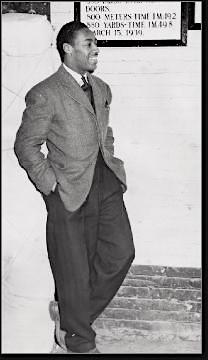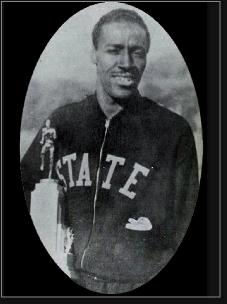
Sport: Track & Field
Born: April 4, 1913
Died: December 23, 1942
Town: Bridgeton, New Jersey
John Borican was born April 4, 1913, in Bridgeton to Charles and Sallie Borican. He had an older brother, Charles Jr., and a younger sister, Mary. A magnificent athlete as a teenager, John combined speed, stamina and coordination with intelligence and creativity. He earned early fame as a football star and track and field athlete at Bridgeton High. John also made headlines at the age of 16 while visiting Chicago. He helped police run down a murder suspect, starting a lifelong fascination with law enforcement. At one point, John took—and passed—the New York City Police Department exam.

After graduating from Bridgeton High, John hoped to run for NYU, but Coach Emil Von Elling refused to offer him a scholarship. John enrolled at Virginia State instead, and captained the track and basketball teams. As a senior halfback in 1934, he was voted to the colored All-America team. John hoped to qualify for the 1936 Olympics as a hurdler but performed poorly at the trials, failing to reach the finals.
John supported himself as a commercial artist while attending Columbia University as a grad student. In 1938, he came under the tutelage of Columbia track coach Carl Merner, and logged countless hours on the school’s indoor oval. John did not compete for the school’s track team because of his age, but dominated in intramural competition. In one meet he won the mile, 440, 880, broad jump and 120-yard hurdles, shattering several school records in the process. John’s speed was matched by his recuperative powers, as he often won multiple middle-distance events at the same meet in the ensuing years.
In 1938, John entered the national spotlight when he won the AAU pentathlon. He repeated as AAU champ in 1939 and again in 1941.
Coach Merner was constantly tinkering with John’s style, trying to shave precious seconds off his time. Once, after a race in Madison Square Garden, Merner began criticizing John for not swinging his arms the way he had instructed him. In the middle of the tirade, the Garden announcer informed the audience that John had just set a new world record. Merner didn’t back off—and John loved him for it.
In March 1939, John and legendary miler Glenn Cunningham were part of a star-studded field in a 1,000-yard event at Madison Square Garden. John sprinted out to a huge lead and not only defeated Cunningham, but set a world record. John’s dream was to become the first African-American world champion in the mile. Unfortunately, he never got the chance. The Olympics were cancelled in 1940, denying “Long John” a chance to go for gold on the world stage. That year, he set a world record of 3:26 in the ¾-mile.
In 1941, John was national champion in both the decathlon and pentathlon, becoming the first athlete to accomplish this double. He also set the American record in the 660, 880, 800 meters and 1,000 meters. That November, John was the subject of a stunning photo essay in LIFE magazine. It featured stop-action photography of him clearing a hurdle and flying through the air during a long jump, as well as throwing the discus. The article hailed him as he greatest all-around athlete since Jim Thorpe. It also showed some of his artwork.
In 1942, John won national titles in the 800 meter outdoor and 1,000 yard indoor, setting three world records in the process. The 1,000 title was his third in a row. John’s fans were looking forward to that year’s Pan American Games in Argentina, which would serve as the “substitute” Olympics. Unfortunately, tension between Argentina and the US led to cancellation of the games.
But John wouldn’t have been able to compete anyway. That September, he fell gravely ill. Over the next three months, his weight plunged from 170 pounds to 110 and doctors were unable to stabilize his health. He died at age 29 in December from pernicious anemia.
The pure embodiment of the student-athlete, John had always excelled in his studies. After graduating from Virginia State, he received a masters in Social Studies from Columbia University and was working on his Fine Arts Ph.D. when he died. He had been supporting himself as a portrait artist, and was the assistant director of the Boys Club in Newark, running the facility on Morton Street. When he died he held world records in 5 different events.